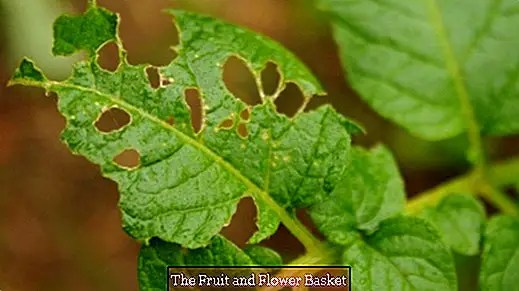Food marks in the garden: recognize and combat pests
Every garden owner can sing a song about it: sowing and sowing, nurturing and caring, fertilizing and petting, tiring and cuddling, looking forward to a rich harvest or overwhelming flowering and one morning: all gone. Or huge holes in the green. Who was it? The harmful images, the usual suspects and what you can do if possible without chemicals, can be found here.
Snails: Only stems left in the vegetable patch
No art to recognize who was at work: snails. Whether it was the yellowish-brown field slug whose adult animals eat the above-ground parts of plants or the red Spanish slug does not matter. What can you do? The best way to help a snail fence in combination with picking up and - I'm so sorry? kill. Then you might get the bed at some point snail-free. If one chooses snail grain, then one with the active substance ferric phosphate. Other substances are suspected of harming birds, bees and earthworms. One can also try to protect its beds with a frame made of snail food: a ring of tagetes around the salad helps, because the snails eat their fill before the vegetables. Perhaps. Mussels as a mulch layer should also help, but an expensive affair if you do not live by the sea.
Incidentally, the smaller, black garden snail, which you can see from time to time, delights in root vegetables and roots. Not nice either.
Black-backed weevil: Bay-like food marks in leaves
The Black-weevil droves its mischief here? also in balcony plants. The nocturnal beetle should be caught: it crawls under laid boards, during the day you can read it off. In an infestation, one should always think of the larvae of the beetle. They are much worse because they feed on the roots and tubers. Here only special nematodes, thread worms, which one can buy in the specialized shop and then exposes in the infested earth help here.
Small Frostspanner: shoot tips and young leaves are eroded and interwoven.
Allow: The Small Frostspanner. The female lays the eggs on the shoot tips in October, the larvae eat in April and May then the young leaves and weave the eroded into a kind of cocoon. With a few larvae, that's not bad, the tree is going out again. But if there are too many or the tree is still young, a lot of energy must be put into the renewal. You can fight the Frostvanner with glue rings: Since the female has no wings, it must climb in the fall on the trunk. A glue ring there and on all support posts prevents this. In December you can remove the glue rings and dispose of them as household waste.
Codworm: worms in apples and pears
The codling moth forms two generations: the first lays the eggs in May / June, the second in August / September. The oviposition takes place smooth surfaces? So either on leaves or fruits, if they have lost their fluff. The caterpillar then feeds on the fruit. In any case, you should pick up the fallen fruit and eliminate it. Fruit coral fishing belts made of corrugated cardboard will also be available from the end of May, which will be regularly renewed.
Wire worms: Eating traces of root vegetables inside and out
Wireworms have probably eaten their fill here. The beetle larvae can be attracted with lock traps, for example with half carrots or potatoes in the soil, which are regularly disposed of including worms. He also likes wheat? if you have enough space, you can sow a row of wheat between the root vegetables. Tagetes and marigolds are poisonous to the worms.
Cabbage white: Cabbage leaves are eroded
The cabbage white is not for nothing: His caterpillar loves cabbage leaves. But you can pick them up or spoil them by planting tomatoes and celery or adding dill, sage, rosemary, thyme, peppermint or mugwort to the edge of the bed.
Carrot fly: carrots, dill, caraway, parsley are eaten
Since the carrot fly has its main flight time from late May to July, one can manage, if one only sows the endangered plants starting from July. Or one protects in the appropriate time its beds by nets.
Voles: Trees and bushes do not drive anymore
Voles are not picky. They gnaw and eat roots, rhizomes, tubers and bulbs of various plant species. Their wandering can also cause considerable damage to grass. Voles leave piles of earth in the garden. Before countermeasures it is important to check if it is really a vole or not a mole. The latter is protected and may only be expelled but not killed. An indication: In vole mice, the hole is always offset laterally to the earth pile. Against voles there are traps, it should also help to grow imperial crown, vole wolf milk and daffodils. Anyone who knows that voles are in the area before planting places the roots of their trees in special wire mesh baskets.Field mice, by the way, eat less at the roots, they rather nibble on the bark.
Neighbor's cat: Long vertical cracks in the tree bark
Prime suspect: Neighbor (or your own?) Cat. Remedy: trunk protection mats.





